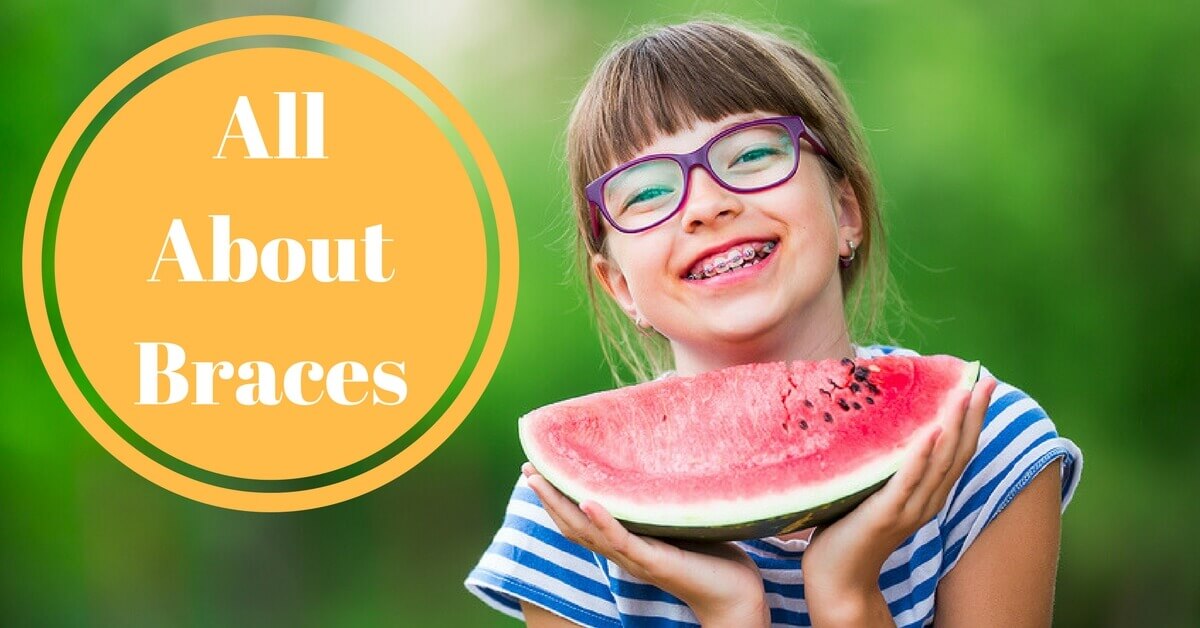Braces are a common way to correct misaligned teeth, bringing out beautiful, healthy smiles. It’s important to be informed about how braces work and what to expect. At Fox Kids Dentistry & Orthodontics, we’re here to help you understand the process every step of the way.
What Are the Different Types of Braces?
There are many different types of braces, and they are not “one-size-fits-all.” At Fox Kids, we’ll work with you to identify the best options for your child.
Traditional Metal Braces
Metal braces are the most time-proven method of adjusting teeth. Small metal brackets are attached to the front surface of each tooth, and a thin wire fits inside of each bracket, which runs from tooth to tooth. Elastic bands securely connect the metal wire to the brackets.
The tiny elastic bands come in a variety of colors and offer a fun way to “dress up” the braces. They get to be changed at every visit, and many patients will coordinate their braces with holiday colors (like orange and black for Halloween) or favorite sports teams (like red and black for the Blazers).
Traditional braces have been refined in the past few decades, so today they are smaller and stronger than ever before. In fact, low-profile braces are gaining popularity as a way to minimize appearance and make them much more comfortable to wear. Low-profile braces are smaller and sit more closely to the surface of the tooth compared to the more traditional style. Metal braces can be used to correct a wide range of orthodontic conditions, from the most minor issues to the most complex.
Traditional Ceramic Braces
Ceramic braces take the same general form as traditional metal braces, but the brackets are made of tooth-colored or clear ceramic, making them significantly less noticeable on teeth. Usually, the wires used are still metal, so it isn’t totally inconspicuous. However, ceramic brackets offer a vast improvement from the more obvious metal brackets.
Lingual Braces
Lingual braces are wire braces adhered to the inner surface (backside or tongue side) of the teeth. Other than hiding the braces from view, this treatment modality offers few advantages and several disadvantages. Lingual braces have the same sorts of food restrictions as traditional braces, and, because of their location, they can affect speech and cause more irritation in the mouth. Of all the types of braces, lingual braces’ capacity for adjusting teeth can be limited due to more difficult access.
Removable Aligners
For mild-to-moderate adjustments, removable aligners like Invisalign provide a flexible, discrete option. Custom-molded clear plastic alignment trays are placed over the teeth to guide them into their correct position. The aligners are also removable, so there are no eating restrictions or special cleaning guidelines.
Every 1-2 weeks, new alignment trays are provided to gradually adjust the teeth. Aligner trays are see-through, making them hardly noticeable visually. Sometimes, tooth-colored attachments, which serve as little handles for the aligners to grab onto, are glued onto the teeth to help the teeth move more smoothly. Invisalign is a common brand of clear aligners that orthodontists commonly use.
Will Braces Hurt?
Braces move teeth in gradual increments, putting pressure on the teeth to reposition them. All forms of braces require periodic adjustments to keep the teeth on course. In the first few days after an adjustment, the new pressure on the teeth can be uncomfortable, but the mouth adapts to the new positioning quickly and the discomfort subsides.
With traditional braces, the edges of the metal or ceramic brackets can rub against the inside of the mouth, creating small areas of irritation. Furthermore, the wires used to straighten the teeth can sometimes poke into the cheeks as the teeth start to align. Patients can use orthodontic wax and press it against the braces or wires that are causing problems. When wax doesn’t work, the orthodontist can also clip the wire that is causing discomfort.
Do Braces Require Special Care?
Getting braces will change your eating routines and dental hygiene habits somewhat. It’s important to know your limits and understand how to properly care for your teeth after you get braces installed. Below are the best habits to practice:
Eating
Braces that are adhered to the teeth make certain foods unadvisable, such as:
- Sweets, sugars, gum and candy can all get easily trapped in the crevasses of braces and can produce rapid tooth decay.
- Foods that are small and hard, like nuts or popcorn, can get easily stuck.
- Hard food items like apples and toasted garlic bread can bend your braces and damage the attachments.
You should also cut up your food into soft, easily manageable bites to prevent issues with your treatment plan.
Cleaning
Teeth undergoing orthodontic treatment with braces should be thoroughly cleaned after every meal to prevent damage to the teeth and gums. You should also brush your teeth twice a day and follow these other cleaning tips:
- Use a water pick on teeth to clear out pieces of food that become trapped behind the brackets.
- Use a soft-bristle toothbrush because it is gentler on the braces and the teeth.
- Start using mouth wash once daily to keep the bacteria in your mouth under control and protect your enamel.
Do Removable Aligners Require Special Care?
Aligner trays, such as Invisalign, are removed for eating and cleaning the teeth, so there are no dietary restrictions or specialized cleaning requirements. An important thing to remember with removable aligners is that although they can be conveniently removed, to work, they must be worn for most of the day, preferably at least 22 out of 24 hours.
Eating
Removable aligners make mealtimes much easier. Just remove your aligners before eating and follow these tips:
- Store your current aligner trays in a protective case while you eat to avoid losing them.
- Get a travel-sized toothbrush for brushing your teeth before you put your aligner trays back in.
- Avoid drinking hot liquids while the aligner trays are in your mouth, as the heat could bend or warp them.
- Avoid drinking tea, soda, coffee or any other beverage that can stain your aligners or leave an odor.
- Remove aligners when drinking anything other than water.
Cleaning
Cleaning your aligner trays is easier than picking your braces, and you have to do it much less frequently. Below are some guidelines for keeping your aligners clean:
- Find a cleaning agent designed for clear aligners or Invisalign.
- If you had to put your aligners in without getting the chance to brush your teeth first, gently brush the aligners with a soft-bristle brush. Scrape out food particles as soon as you can.
- Soak your aligners in distilled water with a little vinegar to remove odors.
How Long Does It Take for Braces to Work?
The length of time braces are needed will vary for each individual case, but it’s important to remember braces are temporary. Most people will only wear braces for a year or two, although some teeth may take longer to straighten. Braces treatments for kids and adults take about the same amount of time, but adults’ teeth may move a little more slowly.
For people who want to try to speed up the process, orthodontic treatment may be accelerated with the use of a gentle vibrating device that can help improve tooth movement. While using the device, some patients have reported less discomfort with tooth alignment.
How Much Do Braces Cost?
How much you pay for braces depends upon your treatment plan, the complexity of your case and how much your insurance will cover. Dental insurance for getting braces in Portland is a good investment if you can choose your health care plan. Many plans allow kids to get low-cost dental services.
The average cost for braces is anywhere between $3,000 and $7,500 without insurance, but you could pay up to $10,000. In comparison, Invisalign is close in price. Your orthodontist will help you decide which treatment is right for you.
Braces for Better Smiles at Fox Kids Dentistry
Fox Kids Dentistry & Orthodontics is committed to compassionate service and great results. Whether you’re checking for orthodontists who can help a child or teen get braces in Portland, we are happy to provide the service. If it’s time for Invisalign or braces in Portland, set up a complimentary consultation today.



